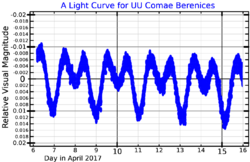Astronomy:21 Comae Berenices
 A visual band light curve for UU Comae Berenices from MOST data. Adapted from Paunzen et al. (2019)[1] | |
| Observation data Equinox J2000.0]] (ICRS) | |
|---|---|
| Constellation | Coma Berenices |
| Right ascension | 12h 31m 00.561s[2] |
| Declination | +24° 34′ 01.80″[2] |
| Apparent magnitude (V) | 5.47[3] or 5.41 – 5.46[4] |
| Characteristics | |
| Evolutionary stage | main sequence[1] |
| Spectral type | A3p SrCr[5] |
| B−V color index | 0.056±0.008[3] |
| Variable type | α2 CVn[1] + δ Sct[4] |
| Astrometry | |
| Radial velocity (Rv) | +1.0±1.8[3] km/s |
| Proper motion (μ) | RA: −12.474[2] mas/yr Dec.: −9.085[2] mas/yr |
| Parallax (π) | 12.0785 ± 0.1214[2] mas |
| Distance | 270 ± 3 ly (82.8 ± 0.8 pc) |
| Absolute magnitude (MV) | 0.66[3] |
| Details[1] | |
| Mass | 2.29±0.10 M☉ |
| Radius | 2.6±0.2 R☉ |
| Luminosity | 38.2±1.3 L☉ |
| Surface gravity (log g) | 3.9±0.2 cgs |
| Temperature | 8,900±200 K |
| Rotation | 2.05219 d |
| Rotational velocity (v sin i) | 63±2 km/s |
| Age | 400–800 Myr |
| Other designations | |
| Database references | |
| SIMBAD | data |
21 Comae Berenices is a variable star in the northern constellation of Coma Berenices.[8] It has the variable star designation UU Comae Berenices, while 21 Comae Berenices is the Flamsteed designation.[7][8][9]
About
According to R. H. Allen, English orientalist Thomas Hyde attributed the ancient title Kissīn to this star, a name that comes from a climbing plant – either bindweed or dog rose.[6] This star has a white hue and is just visible to the naked eye with an apparent visual magnitude that fluctuates around 5.47.[3] Based upon parallax measurements, it is located at a distance of approximately 270 light years away from the Sun.[2] It is a single star but is a confirmed physical member of the Melotte 111 open cluster.[10]
History
This object has been studied extensively since 1953, producing some occasionally contradictory results such as hints of pulsational behavior or a binary companion. It is a weakly magnetic chemically peculiar star of type CP2, or Ap star, that is most likely on the main sequence.[1] The stellar classification is A3p SrCr,[5] where the suffix notation indicates abundance anomalies of the iron-peak element chromium, as well as strontium.
This is an Alpha2 Canum Venaticorum (ACV) variable, which indicates it varies in luminosity as it rotates due to spots on its surface created by a magnetic field. The range of variation has an amplitude of 0.02 magnitude and a period of just over two days.[1] Samus et al. (2017) have it classified as a low-amplitude Delta Scuti variable,[4] although this is disputed.[1]
The age of the Melotte 111 cluster, and therefore this star, lies in the range of 400–800 million years. The star has a projected rotational velocity of 63 km/s, with a polar inclination of 64° or greater, resulting in a rotation period of 2.05 days. Stellar evolutionary models yield a mass of around 2.3 times that of the Sun and 2.6 times the Sun's radius for this object. It is radiating 38 times the luminosity of the Sun from its photosphere at an effective temperature of 8,900 K.[1]
References
- ↑ 1.0 1.1 1.2 1.3 1.4 1.5 1.6 1.7 Paunzen, Ernst et al. (May 2019), "A revisit to the enigmatic variable star 21 Comae", Monthly Notices of the Royal Astronomical Society 485 (3): 4247–4259, doi:10.1093/mnras/stz413, Bibcode: 2019MNRAS.485.4247P.
- ↑ 2.0 2.1 2.2 2.3 2.4 Brown, A. G. A. (2021). "Gaia Early Data Release 3: Summary of the contents and survey properties". Astronomy & Astrophysics 649: A1. doi:10.1051/0004-6361/202039657. Bibcode: 2021A&A...649A...1G. Gaia EDR3 record for this source at VizieR.
- ↑ 3.0 3.1 3.2 3.3 3.4 Anderson, E.; Francis, Ch. (2012), "XHIP: An extended hipparcos compilation", Astronomy Letters 38 (5): 331, doi:10.1134/S1063773712050015, Bibcode: 2012AstL...38..331A
- ↑ 4.0 4.1 4.2 Samus', N. N; Kazarovets, E. V; Durlevich, O. V; Kireeva, N. N; Pastukhova, E. N (2017), "General catalogue of variable stars: Version GCVS 5.1", Astronomy Reports 61 (1): 80, doi:10.1134/S1063772917010085, Bibcode: 2017ARep...61...80S.
- ↑ 5.0 5.1 Renson, P.; Manfroid, J. (2009), "Catalogue of Ap, HgMn and Am stars", Astronomy and Astrophysics 498 (3): 961–966, doi:10.1051/0004-6361/200810788, Bibcode: 2009A&A...498..961R.
- ↑ 6.0 6.1 Allen, Richard Hinckley (1963), Star Names: Their Lore and Meaning, Dover Publications Inc., p. 171, https://penelope.uchicago.edu/Thayer/E/Gazetteer/Topics/astronomy/_Texts/secondary/ALLSTA/Coma_Berenices*.html, retrieved 2019-11-01.
- ↑ 7.0 7.1 "21 Com". SIMBAD. Centre de données astronomiques de Strasbourg. http://simbad.u-strasbg.fr/simbad/sim-basic?Ident=21+Com.
- ↑ 8.0 8.1 "21 Comae Berenices - Star in Coma Berenices | TheSkyLive.com". https://theskylive.com/sky/stars/21-comae-berenices-star.
- ↑ Guide, Universe (25 January 2015). "21 Comae Berenices Star Facts" (in en-US). https://www.universeguide.com/star/61071/21comaeberenices.
- ↑ Silaj, J.; Landstreet, J. D. (2014), "Accurate age determinations of several nearby open clusters containing magnetic Ap stars", Astronomy & Astrophysics 566: A132, doi:10.1051/0004-6361/201321468, Bibcode: 2014A&A...566A.132S.
 |

